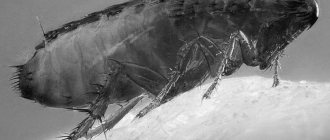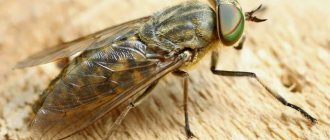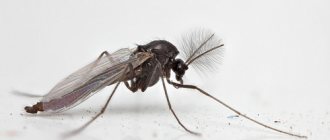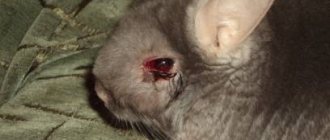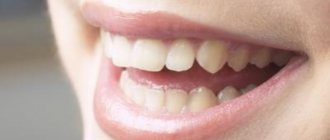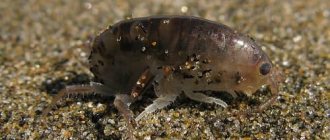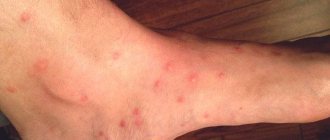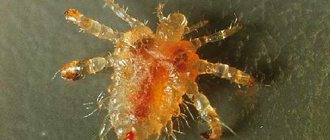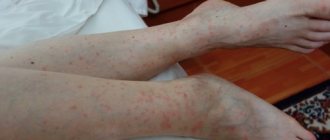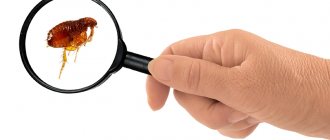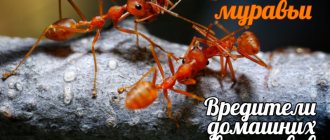How to recognize a flea bite
During a flea bite, a person may feel pain comparable to a needle prick. Some people do not notice how fleas bite, but after a while the affected area makes itself felt with severe itching.
Bedbug bites are often confused with flea attacks. Signs by which insect bites can be distinguished:
- Fleas often bite a person's legs. This is explained by the fact that they are not able to crawl along the body, and when jumping they can only reach the legs of their prey. Therefore, flea bites on human legs are common. However, in a dream they are capable of biting any open areas of the body. Bedbugs bite a sleeping person in bed mainly at night and can reach any part of the body that is not covered by thick clothing.
- A bug bite is a reddened and swollen spot. Flea bites are distinguished by the presence of a red dot in the center of the reddened area - dried blood.
- When a bug bites, saliva enters the wound, which has an analgesic property, and the victim does not feel anything. Fleas do not have such characteristics and, when they bite through the skin, cause significant discomfort to a person.
Below is a photo of flea bites on a person. If you cannot determine exactly which insect bit you, you should consult a dermatologist. He knows what flea bites look like and will give recommendations on how to treat them.
Flea bites
Why do fleas bite?
Fortunately, humans are not suitable “housing” for fleas, because fleas need thick hair to keep them safe. It is for this reason that parasites settle on dogs, cats, and in rare cases, birds. But despite this, fleas bite both animals and people. After the parasite tastes human blood, it returns back to the pet.
The question, “Do dog or cat fleas bite humans?” directly depends on the number of parasites. In the case of a small amount, an animal is enough for them. But if fleas are not noticed in time, or ignored altogether, then their number grows, and accordingly, sooner or later, one pet will not be enough for them. That is, a person for them is just a new source of food.
Consequences of flea bites
For most people, one or two affected areas do not pose a threat to health. But in the case of multiple wounds, the following consequences of flea bites occur:
- the feet are very itchy, and the person cannot control it;
- Constant scratching leads to serious damage to the skin, as a result of which infection can get into the wounds;
- flea bites scratched until they bleed swell even more;
- the victim becomes nervous, insomnia appears;
- prolonged absence of treatment can lead to serious psychological disorders;
- fleas are carriers of dangerous diseases such as plague, hepatitis, tick-borne encephalitis, anthrax, brucellosis and others.
Important!
In people with hypersensitivity and prone to allergies, even one flea bite can provoke a severe allergic reaction. Failure to provide timely assistance in such cases leads to serious consequences.
Consequences of insect bites
Most adults easily tolerate the consequences of flea bites. They may not even experience much itching. Usually the affected areas heal within a week. The situation is different with allergy sufferers and children. They have an allergic reaction to the insects' saliva, which acts as a poison for sensitive people. Symptoms of a flea bite on a person prone to allergies are quite severe:
- increased body temperature;
- severe swelling and itching;
- diarrhea;
- weakness of the body;
- headache;
- dizziness;
- labored breathing;
- rapid pulse.
Why are they dangerous?
Fleas cause the development of pulicosis and sarcopsillosis. Pustules, ulcers, and if left untreated, blisters appear. Moreover, parasites cause and transmit such dangerous diseases as:
- hepatitis B and C;
- myxomatosis;
- encephalitis;
- fibroma of rabbits.
When a person scratches a wound, he opens the door to infectious diseases. Some people are allergic to flea bites, which in severe cases can lead to anaphylactic shock.
Treatment of bites
To successfully treat damaged areas of skin on the body, you need to prevent repeated flea attacks. To do this, you need to find out where the parasites came from in the house. The main source of this type of insect is pets: cats and dogs. They are the ones who most often become victims of fleas. If parasites are found in an animal's fur, the necessary measures should be immediately taken to eliminate them.
On a note!
A cat flea bite is no different from dog or rabbit parasites. They can equally feed on the blood of any animal and human. However, cat fleas are the most common. After eliminating the insects in the house, you can begin treatment.
There are many ways to get rid of flea bites on a person. Among them are traditional methods of relieving symptoms, which use inexpensive inexpensive means and specially developed antihistamines and healing drugs sold in pharmacies.
Prevention
Encountering fleas is a common occurrence in a person’s daily life, and it is impossible to completely protect yourself and your loved ones from this scourge. However, certain preventive measures will help reduce the likelihood of encountering dangerous insects to a minimum:
- Do general cleaning of your home regularly. Ventilate rooms and clothes hanging for a long time without use, beat out carpets, keep soft children's toys and pet accessories clean;
- systematically examine your four-legged and feathered pets for the presence of parasites, purchase anti-flea collars or special sprays for them to prevent the appearance of parasites;
- promptly block possible access routes for insects to your home: cracks in door jambs, window frames, floors;
- periodically treat the premises with modern means to combat insects in the house or use an electronic repeller;
- When planning a trip to a place where the likelihood of meeting little vampires is high, apply repellents containing the substance DEET (diethyltoluamide) to your skin. The most popular means are: OFF Extreme;
- Moskitol Super Active protection;
- Medilis comfort;
- Ultratone.
Natural repellents include:
- sagebrush;
- mint;
- tansy;
- chamomile;
- lavender;
- eucalyptus.
Bunches of plants are hung throughout the rooms, placing them as close to the floor as possible. In addition, you can prepare a fragrant spray from any herb and apply it to clothing or skin (if you are not allergic). To do this, brew 50–100 g of any plant with 1 liter of boiling water, let it cool, then pour it into spray bottles and use it for its intended purpose.
Photo gallery: modern means of preventing and controlling fleas at home
Spray Raptor destroys adult fleas and insect larvae
The activity of Chlorpyrimark can last up to one and a half months
Aerosol Raid allows you to quickly treat your home
The microencapsulated drug Get is considered one of the best for fighting parasites in the home
Pyrethrum is made from ground chamomile flowers and is used for treating rooms in hard-to-reach places.
Dichlorvos Varan is safe for people and animals
A harmless drug sold in veterinary pharmacies - Butox
Biorin is an effective but very toxic product used by professional exterminators
Folk remedies
Treating the site of a flea bite
Treatment of flea bites can be carried out using improvised means that are found in almost every home. Depending on the degree of damage to the skin areas, a specific option for treating bites is chosen:
- In cases where flea bites on a person’s body are slightly red, you can get by by washing with warm water and soap. Apply brilliant green or iodine to clean, dry skin around the wound. After 2-3 days, repeat the procedure. For a cooling effect, you can use a regular ice cube from the freezer.
- Table vinegar, alcohol, and cosmetic lotions are perfect for disinfection. They are applied to a cotton swab and wiped over the damaged skin several times a day.
- To get rid of itching and relieve swelling, it is recommended to make lotions with the juice of aloe, plantain, green tea, chamomile, and calendula. You can also wipe your skin with fresh lemon juice.
On a note!
If, after 5 days, treating bites with improvised means does not help, you need to switch to more effective pharmaceutical drugs.
Review
Once in my childhood I was vacationing in the village with my grandmother and I was very badly bitten by fleas. The skin itched terribly, and I scratched it until it bled. Grandmother insisted on calendula and chamomile, which grew in her front garden. Then she wiped my bites with this solution. After a few days the wounds healed. After this incident, I believed that I could do without expensive drugs from the pharmacy.
Leonid, Kostroma
Destruction of fleas in Pokrov
Finding these parasites is not difficult. But after you already know that they live with you, the question arises - “what to do next?” First of all, examine the pets and carry out a special treatment with insecticidal drops, lotions or sprays; you can wash the animal with a special shampoo. There are many different products that can be purchased at a veterinary store.
At the same time, you need to destroy fleas in the apartment itself. They, like many parasites, can hide in various crevices, furniture that has pile, carpets, etc. Fleas will not live long in an open environment because they need regular food. But if you ignore the “cleaning” of the apartment, you can give your pet a chance to become infected again.
There is the following sequence of actions after detecting parasites in an apartment:
- Carry out a wet general cleaning of the apartment;
- Wash everything possible (clothes, curtains, carpets, etc.)
- Treating all cracks, walls, furniture with a special product;
- Ventilate the room well.
But you need to know that complete treatment and cleaning does not protect you from the return of parasites. Especially if your pet loves to go outside. In this case, it is recommended to purchase a special collar - it has the property of repelling these parasites. Or you can use special drops (for example, Bars). Also, do not allow such pets into your bed.
In case of severe infection of the apartment, it is best to call the SES service. The sanitary and epidemiological station will destroy fleas much faster and you won’t have to rack your brains. SES employees offer comprehensive services for the destruction of parasites. You can call the housing maintenance office (ZhEK) to call the SES in Pokrov.
Pharmacy drugs
Today, pharmacies offer a large selection of remedies to treat insect bites. The use of a particular drug should depend on the degree of damage to a person’s skin by parasites and the victim’s predisposition to allergic reactions. The most popular types of medications for treating flea bites include:
- antihistamines – relieve swelling and itching;
- ointments, gels, creams - heal the skin;
- balms – relieve redness and swelling;
- antibacterial solutions - disinfect combed areas of the skin.
Important!
Before using any pharmaceutical drug, you must carefully read the instructions. The active substances contained in medications may cause allergies or side effects.
Fenistil Gel
Ointments for flea bites
A popular ointment for flea bites and other insects has an antiallergic effect on the affected area. The active ingredient dimethindene reduces irritation and itching, eliminates swelling. Fenistil Gel has a cooling effect on the wound, thereby eliminating pain.
Fleas and their types
Have you ever experienced bites from insects such as fleas? I don’t remember similar cases in recent years, but in childhood I suffered from this scourge several times. The attack of parasites does not go unnoticed, as it is accompanied by sharp pain, but it is extremely difficult to catch a flea because it moves at very high speed. And only now I thought about what kind of fleas can bite a person? Where do they come from? What places are you most likely to encounter these insects?
Despite the fact that science knows more than 2 thousand species of fleas, the potential danger of bites comes from only about 500 of them. The most famous and frequently encountered include:
- human flea;
- ground flea;
- dog flea;
- cat flea;
- rat flea;
- rabbit flea.
What species a flea belongs to can only be determined under a microscope.
One of the dangerous representatives of parasites is the sand flea. The female burrows into human skin, and after some time a large number of eggs begin to form in her body. The insect increases in size, and severe suppuration occurs at the site of the lesion. A belated visit to the doctor or the hope that the abscess will disappear without medical intervention can lead to amputation of the limb.
It is very difficult to determine which species the insect that bit you belongs to, since they are all very small in size. However, the symptoms of bites from all parasites of this family are very similar.
Main symptoms of a bite
A flea bite is accompanied by severe pain. This is explained by the fact that this insect, unlike bed bugs and ticks, does not have an anesthetic component in its saliva. Almost immediately after the parasite comes into contact with the skin, redness and swelling occur at the site of the bite, accompanied by pain. Severe itching and a desire to scratch the damaged area appear. The insects most often attack the legs, from the ankles to the knee, but sometimes the little vampires reach other parts of the body. Fleas can bite once or several times in a row, leaving a series of wounds with a distance of 1-2 centimeters between them.
The human body can react to flea bites in different ways. For some people, itching and redness disappear within a few hours after contact, while for others, skin reactions may persist for two or more days, accompanied by prolonged redness and significant thickening.
The areas of skin most often affected by flea bites are the ankles.
There is an opinion that only those who have delicate skin are susceptible to flea attacks. This is wrong. The parasite's jaws are quite powerful and can bite through absolutely any skin. People who are less sensitive and not prone to allergies may simply not feel an insect bite.
In children, the reaction to the bites of blood-sucking parasites is more severe, since the skin of babies is very delicate and the immune system is not strong enough.
Reader reviews
It’s very simple... They bite people of blue blood, that is, those who have blood vessels and veins located close to the skin. They usually bite the palms, arms, neck and behind the ears because the skin is thinner there. They will not bite through thick skin. Fleas have eaten me and my son, but they don’t bite my brother.
Nastya
https://www.woman.ru/home/medley9/thread/3877475/2/
Oh God!!!! In our apartment it’s not clear where the fleas came from!!! We did not have and do not have pets!!! Where does such a misfortune come from?! A few days ago in the morning I discovered strange bites on my legs and stomach! large red spots that are very itchy! Naturally, I thought about mosquitoes, but mosquito bites are still marked completely differently for me and go away in one day, but here the spots last for the third day!!! And yesterday I caught this rubbish with my own hands on my bed!!! The bed was immediately shaken up, changed, and today I found a flea on it again!!! What to do?!!! How to escape from this rubbish??? For as long as we have been living in an apartment, there has never been anything like this!!! The situation is further aggravated by the fact that we have an infant and you won’t be able to use much chemicals here!…
KatYu
https://www.kid.ru/forum/txt/index.php/t53200.html
I also thought that fleas only bite animals, but it turns out not! such a small bite, but it itches like hell! I already called KSK and said everything I thought about them. They promised that they would come one of these days. For now, I’m thinking about buying flea shampoo and using it to wash everything in the apartment. God, what a nightmare, I had a dog for 15 years, this has never happened before! I'm just shocked!!!
bebo_bi
https://vse.kz/topic/410397-menja-kusajut-blohi/
oh, fleas are such a thing. My mother has an invasion of them now. They bit everyone. But he doesn’t really want to poison them because they disappear for a month at most, and it takes a lot of money and effort. True, they don’t particularly like to eat animals. And a well-fed flea after a cat will not climb on a person. So no need to panic I think. At least we don't even think about it
Alexandrochka
https://www.babyblog.ru/community/post/living/1761067
What to do if bitten by a flea?
If you find flea bites on your body, do not scratch the affected areas of the body under any circumstances, but immediately wash them with running water and antiseptic soap. It is recommended to treat the bite site with calamine soothing lotion, but if this is not available, use alternative treatment methods.
You can treat the affected area of the body with water and apple cider vinegar. Mix the necessary ingredients in a 1:2 ratio and refrigerate. Soak a thin cloth in the cooled liquid and apply it to the bitten area.
A paste made from sodium bicarbonate and water relieves itching well. The resulting paste is applied to the bite site for 15 minutes. You can also prepare a liquid from 250 ml of water and lemon peel. The infused mixture is used to treat itchy areas.
Appearance of the parasite
Fleas are very different from other bloodsuckers in their appearance. Their length is about 3-5 mm , so it is quite difficult to notice these insects. The body is slightly oblong and rounded, increasing towards the rear. The sides are slightly flattened .
These parasites have a very strong shell made of chitin , making them difficult to crush. The most common color is black or brown. These bloodsuckers have three pairs of legs, with the longest and strongest ones being the hind ones; with their help, adult individuals can jump over distances of up to half a meter.
The entire parasite is covered with small bristles . The head is round in shape, slightly flattened. It has two eyes and two antennae. The insect's mouth is practically invisible. It looks like a tiny proboscis on which powerful jaws are located.
Fleas that pose a danger to humans
Among obligate parasites, the main feature of which is that their entire physiology is configured to feed exclusively on blood, fleas occupy an important place. Typically, these insects parasitize warm-blooded animals such as dogs, cats, birds, rats, pigs, horses, cows and others. But this does not mean that they do not threaten a person, it is just that he is rarely the main host, more often a temporary one, intended solely for maintaining life or transferring if there is no other object more suitable for this purpose nearby. Human body temperature, lower than that of animals, poor hair, good hygiene - all these conditions make people unsuitable for fleas.
It should be noted that there are exceptions to this rule, which include the so-called human flea, whose oral apparatus is optimally prepared for piercing the skin of people, and the characteristics of its life activity are closely related to human housing. Although some small animals such as dogs and cats can also become victims of this insect.
Of the more than 2,000 varieties of fleas, almost all can bite a person, but you should consider those that account for the bulk of the bites.
The bulk of bites occur:
Dog fleas
It is this type of flea that bites people more often than others. This situation can be explained by the large number of these parasites, which can live even on one pet. In addition, dogs are constantly on the street, where they come into contact with possible sources of infection.
Cat fleas
The prevalence of fleas of this species in the world is significant; they can feed on many species of mammals. They move to people for the purpose of feeding due to the fact that there are usually not many of their original owners, cats, in the house.
Rat fleas
In modern cities, they rarely parasitize humans, but for rural areas and the private sector, the problem of bites by this type of insect remains relevant. In addition, it is rat fleas that usually carry the most terrible diseases, so they pose the greatest infectious danger.
Rabbit fleas
This type of parasite rarely affects people, but compared to the remaining unlisted insects, the percentage of their bites is the highest.
It should be understood that all other types of fleas, which traditionally parasitize other animals or birds, can bite through human skin and begin to feed on his blood, so there are no fleas that are safe for people.
What is each of the listed types?
Let's start with the human flea, since for it people are the main source of food.
Externally, this type of parasite differs little from its relatives. They are distinguished by their larger size, which sometimes reaches 4 mm. Such a large individual can jump half a meter in length. The body of the parasite is flattened to the sides; antennae and piercing-sucking mouthparts are located on the small head. Due to the small size of the “mouth,” the flea is not always able to reach the blood vessel directly, so at the moment of the bite it is forced to immerse the entire head and front part of the body into the skin of the victim, making its way as deep as possible. At this moment, her body is almost vertical. The picture is completed by 6 legs, of which the hind ones are designed to make leaps tens of times greater than the size of the insect itself. The flea's jump is so rapid that the human eye is unable to discern it, so all that is visible is how the parasite disappears.
The structural features allow these insects not to be afraid of damage when a person catches them or scratches the bite sites; the dense upper shell protects the individual from being crushed.
The structure of their paws and antennae helps them stay on the host, although these insects do not live on it permanently. Adults spend most of their existence in secluded places located near permanent human habitation. When hungry, they lie in wait for people or animals passing by and jump on them, then, after piercing the skin, suck blood. Having had enough, the parasites try to leave the host’s body. Interestingly, this parasite can exist without food for about one and a half years.
The female lays several eggs at a time, but they do not attach to the hair or skin, but fall down, filling floor and wall cracks, carpet and furniture pile, and animal bedding. Here the larvae develop in organic debris. They feed on the excrement of adults or rotting organic matter. Their length does not exceed a few millimeters, the body is worm-shaped and white in color. After a few weeks, the larva turns into an adult insect, but only if there is a food source nearby, otherwise it can remain in the cocoon until the opportune moment.
Adult fleas live for several months, during which time they can lay about five thousand larvae.
Cat, rat and dog fleas are similar in physiological structure to each other and to the human species. The difference is related to color and size, but they are so insignificant that only a specialist can recognize them using equipment.
